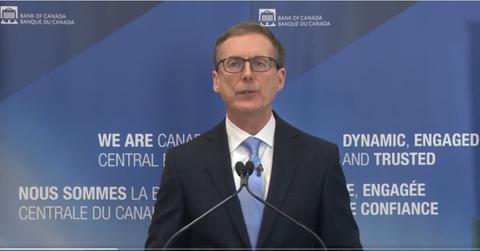Why Did the Bank of Canada Raise Rates? First Series of Hikes Announced
On March 2, the Bank of Canada announced the first of a series of small interest rate hikes to 0.5 percent. The rates are increasing to combat inflation.
March 2 2022, Published 2:15 p.m. ET
On March 2, the Bank of Canada announced an interest rate hike that brings its benchmark interest rate to 0.5 percent. The increase is expected to be only the first in a series of incremental increases over the next year. Here's why the Bank of Canada is increasing rates.
Like in the U.S. when the Fed raises interest rates, the Bank of Canada’s move could have an impact on numerous financial aspects of consumers’ lives, like mortgage interest rates for homebuyers and rates earned on savings accounts. Canada’s rising inflation was cited as one key reason for increasing the rates now.
The Bank of Canada rate decision was based on factors including inflation and the Ukraine crisis.
The Bank of Canada made its rate decision largely because of increasing inflation. According to CBC News, the Canadian bank has been planning on these interest rate hikes for some time now.

Tiff Macklem, Governor of the Bank of Canada, announced the rate hike today.
In January, the Bank of Canada Governor Tiff Macklem gave a preliminary announcement to expect a rise in interest rates, Reuters reported. He stated that the bank would be “clear and deliberate” to ensure that monetary policy wouldn’t cause further uncertainty.
The bank noted that the Canadian economy had grown at a rate of 6.7 percent in the last quarter of 2021. “This is stronger than the Bank's projection and confirms its view that economic slack has been absorbed,” the Bank statement read. The bank also noted that after labor market setbacks due to the omicron variant of the COVID-19 virus, the economy was rebounding well and household spending could be expected to rise as pandemic restrictions lift.
The recent Russian invasion of Ukraine is a “major new source of uncertainty” as well, the Bank of Canada stated. As the economic insecurity has caused increased pricing on fertilizer, natural gas, and oil, other products in Canada could become more expensive.
“The invasion of Ukraine is putting further upward pressure on prices for both energy and food-related commodities,” the Bank noted in its press release. The Bank of Canada will continue to take measures aimed at lowering inflation to its 2 percent target (currently its CPI inflation is at 5.1 percent).

The Bank of Canada hasn’t raised interest rates since 2018.
Between October of 2018 and March of 2020, Canada’s interest rate was 1.75 percent. At that point, it cut the rate down to 0.25 percent due to the COVID-19 pandemic, a rate it has remained at until now.
As the Bank of Canada stated in its press release on March 2, this policy rate is “the Bank’s primary monetary policy instrument.” The Bank of Canada expects that it will need to continue raising rates at intervals throughout the year. April 13, 2022, is the next scheduled date for announcing the overnight rate target.
The Bank of Canada has been in a reinvestment phase as well. It indicated that quantitative tightening is expected as interest rates are raised. The timing of quantitative tightening and future interest rate hikes will depend on ongoing economic developments and how well the country is doing at getting to that 2 percent inflation target.

